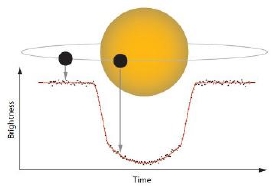Dec 14 2008
U.S. astronomers and engineers have built a new camera to precisely measure the size of planets moving around distant stars. This camera has been dubbed OPTIC ¡X short for ¡¥Orthogonal Parallel Transfer Imaging Camera.¡¦According to the research team, it is so sensitive that it could detect the passage of a moth in front of a lit window from a distance of 1,000 miles.¡¦ I¡¦m not sure if this analogy is right, but the team said it was able to precisely define the size of a planet called WASP-10b which is orbiting around the star WASP-10, about 300 light-years from Earth.
 John Johnson, Institute for Astronomy, University of Hawaii at Manoa
John Johnson, Institute for Astronomy, University of Hawaii at Manoa
You can see above how this ultra-sensitive camera works. ¡§When the planet WASP-10b crosses the disk of its star, WASP-10, the brightness of the star decreases, allowing scientists to measure the precise size of the planet.¡¨
The research team was led by astronomer John Johnson of the Institute for Astronomy (IfA) at the University of Hawaii at Manoa. Here are some Johnson¡¦s comments. ¡§¡¥While we know of more than 330 planets orbiting other stars in our Milky Way galaxy, we can measure the physical sizes of only the few that line up just right to transit,¡¦ explains Johnson. The team studied a planet called WASP-10b, which was thought to have an unusually large diameter. They were able to measure its diameter with much higher precision than before, leading to the finding that it is one of the densest planets known, rather than one of the most bloated.¡¨
The OPTIC camera was designed by another IfA astronomer, John L. Tonry. ¡§It uses a new type of detector, an orthogonal transfer array, the same type used in the Pan-STARRS 1.4 Gigapixel Camera, the largest digital camera in the world. These detectors are similar to the CCDs (charge-coupled devices) commonly used in scientific and consumer digital cameras, but they are more stable and can collect more light, which leads to higher precision.¡¨
Here are some results obtained by the astronomers. ¡§Bigger planets block more of the star¡¦s surface and cause a deeper brightness dip. The diameter of WASP-10b is only 6 percent larger than that of Jupiter, even though WASP-10b is three times more massive. Correspondingly, its density is about three times higher than Jupiter¡¦s. Because their interiors become partially degenerate, Jovian planets have a nearly constant radius across a wide range of masses. The photometric precision is three to four times higher than that of typical CCDs and two to three times higher than the best CCDs, and comparable to the most recent results from the Hubble Space Telescope for stars of the same brightness.¡¨
This research work will be published in a future issue of the The Astrophysical Journal Letters under the name ¡§A Smaller Radius for the Transiting Exoplanet WASP-10b.¡¨
A preprint is available on the arXiv.org website. Here is a link to the abstract. ¡§We present photometry of WASP-10 during the transit of its short-period Jovian planet. We employed the novel PSF-shaping capabilities the OPTIC camera mounted on the UH 2.2m telescope to achieve a photometric precision of 4.7e-4 per 1.3 min sample. With this new light curve, in conjunction with stellar evolutionary models, we improve on existing measurements of the planetary, stellar and orbital parameters. We find a stellar radius Rstar = 0.698 +/- 0.012 Rsun and a planetary radius Rp = 1.080 +/- 0.020 Rjup. The quoted errors do not include any possible systematic errors in the stellar evolutionary models. Our measurement improves the precision of the planet¡¦s radius by a factor of 4, and revises the previous estimate downward by 16% (2.5sigma, where sigma is the quadrature sum of the respective confidence limits). Our measured radius of WASP-10b is consistent with previously published theoretical radii for irradiated Jovian planets.¡¨